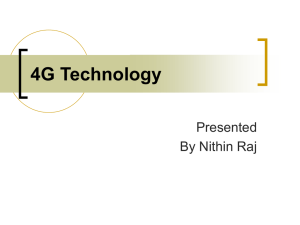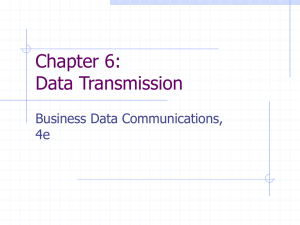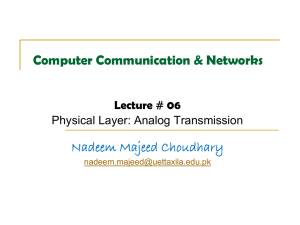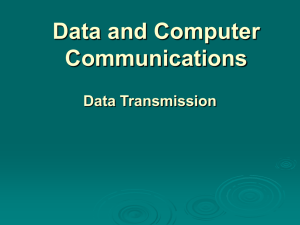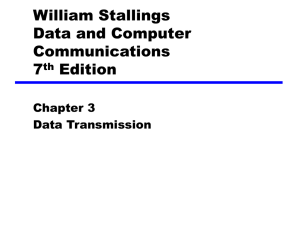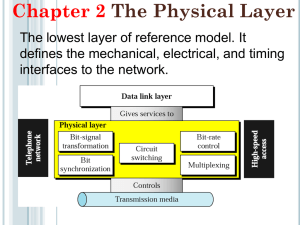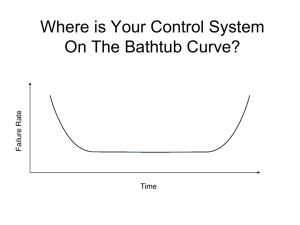ppt - Courses
advertisement
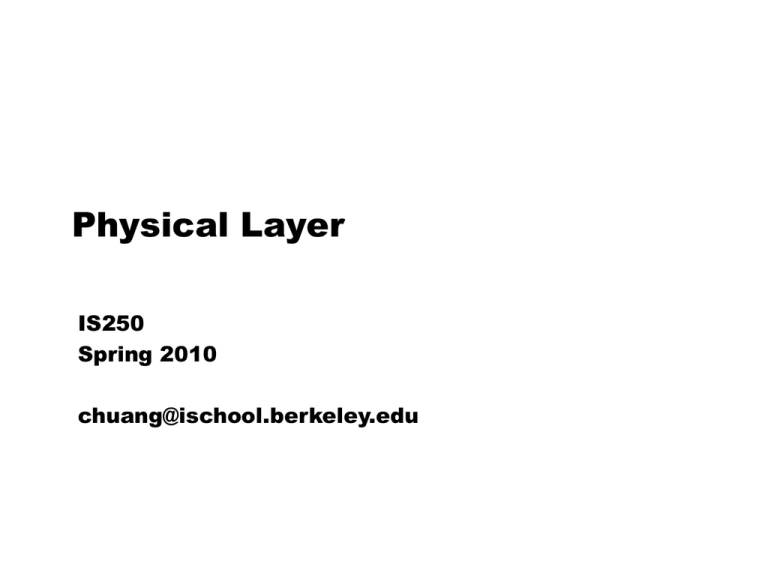
Physical Layer IS250 Spring 2010 chuang@ischool.berkeley.edu Summary Physical layer is concerned with the communication of data encoded as signals transmitted over a medium - Fundamental techniques: encoding, modulation, multiplexing Channel capacity influenced by hardware bandwidth, encoding scheme, transmission impairments (noise and attenuation) 2 Outline Fundamental concepts - Data, signal, transmission (Ch. 5) Transmission media (Ch. 7) Multiplexing (Ch. 11) Transmission impairments (Ch. 8.2) Data encoding (Ch. 6, 10) Channel capacity (Ch. 7) 3 Communication System Transmitter, receiver, medium http://i.ehow.com/images/GlobalPhoto/Articles/4996474/illustration-main_Full.jpg 4 Communication System Transmitter, receiver, medium Data, Signal, Transmission - Data: entities that convey meaning (can be digital or analog) - Signals: electric or electromagnetic representations of data (can be digital or analog) - Transmission: communication of data by propagation and processing of signals 5 Data and Signal Digital data, digital signal Analog data, digital signal Data Digital data, analog signal Analog data, analog signal 6 Transmission Media Guided (wired): twisted pair, coaxial cable, optical fiber Unguided (wireless): RF, microwave (terrestrial & satellite), infra-red 7 Frequencies you may be using today Radio: 535-1605kHz (AM); 88-108MHz (FM) TV: 54-88MHz; 174-216MHz; 470-806MHz Cell phones: 850, 900, 1800, 1900MHz Cordless phones: 900MHz, 2.4GHz, 5.8GHz Wi-Fi: 2.4GHz (802.11b/g); 5GHz (802.11a) Q: how do radio/tv stations and receivers, cell phones and towers, etc., share the airwaves? Q: how are 500 channels of TV programming sent over the cable? 8 Multiplexing Combining multiple data streams into a single signal - Allows resource sharing (e.g., of a communication channel) Many different forms of multiplexing - Time division multiplexing (TDM) - GSM, SONET - Frequency division multiplexing (FDM) - Applications: Broadcast radio/TV, DSL - Wave division multiplexing (WDM) for fiber optic communication - Orthogonal FDM (OFDM) used in DSL, 802.11, 802.16, etc. - Spread spectrum - Flavors: Frequency hopping (FHSS), direct sequence (DSSS) - Transmitter & receiver coordinates via pseudo-random number generator - Basis for CDMA (code-division multiple access) technologies - Spatial multiplexing - e.g., wireless MIMO antennae used in 802.11n 9 Outline Fundamental concepts - Data, signal, transmission (Ch. 5) Transmission media (Ch. 7) Multiplexing (Ch. 11) Transmission impairments (Ch. 8.2) Data encoding (Ch. 6, 10) Channel capacity (Ch. 7) 10 Transmission Impairments Signal received may differ from signal transmitted - Analog transmission: degradation of signal quality - Digital transmission: bit errors Causes - Attenuation - Noise Source: http://www.telebyteusa.com/primer/fig9.gif 11 Attenuation and Noise Attenuation - Signal strength falls off with distance - Received signal strength: - must be enough to be detected - must be sufficiently higher than noise to be received without error - Attenuation is an increasing function of frequency Noise: additional signals inserted between transmitter and receiver - Thermal: thermal agitation of electrons (also called “white noise”) - Intermodulation: signals that are the sum and difference of original frequencies sharing a medium - Crosstalk: signal from one line is picked up by another - Impulse: irregular pulses or spikes that are high in amplitude and short in duration, e.g., external electromagnetic interference 12 Analog v. Digital Transmission Digital transmission better than analog transmission in supporting long distance communication. Why? Analog signal transmitted without regard to content - Signal is subject to attenuation and noise - Amplifiers can be used to boost signal strength, but noise is also amplified Digital transmission involves processing of content - Signal is subject to attenuation and noise - Repeaters can be used to boost signal strength - Repeater receives signal, extracts bit pattern, retransmits clean signal without noise - Attenuation is overcome, and noise is not amplified 13 Outline Fundamental concepts - Data, signal, transmission (Ch. 5) Transmission media (Ch. 7) Multiplexing (Ch. 11) Transmission impairments (Ch. 8.2) Data encoding (Ch. 6, 10) Channel capacity (Ch. 7) 14 Encoding Techniques Digital data, digital signal Analog data, digital signal Data Digital data, analog signal Analog data, analog signal 15 1. Digital Data, Digital Signal Digital signal as discrete, discontinuous voltage pulses - Binary data encoded into signal elements - Bit duration (function of data rate), voltage levels have to be specified Example 1: RS-232 Example 2: USB - USB uses NRZI (non-return-to-zero inverted) encoding - Presence of transition encodes a “1” - Absence of transition encodes a “0” - Data rates: 1.5Mbps, 12Mbps, 480Mbps 3.2v 0v 16 2. Analog Data, Digital Signal Step 1: convert analog data into digital data via sampling and quantization (e.g., pulse code modulation) - Example: 4-bit PCM - Analog data input (in red) 16 quantized levels can be represented using 4 bits Therefore each sample converted into 4 binary bits Digital data output: 1001101111001101111011101111… Step 2: digital data can then be transmitted using digital encoding schemes (previous slide) Variations: delta PCM, adaptive DPCM 17 3. Analog Data, Analog Signals Example: broadcast radio, TV Carrier signal modulated by analog data Types of analog modulation carrier data - Amplitude modulation (AM) - Frequency modulation (FM) - Phase modulation (PM) Why modulate analog signals? - Higher frequency can give more efficient transmission - Permits frequency division multiplexing by using different carrier frequencies for different channels (see slide on multiplexing) 18 4. Digital Data, Analog Signal Example: using a modem (modulatordemodulator) to send data over analog public telephone system Digital Modulation very similar to Analog Modulation: - - ASK (amplitude shift keying): values represented by different amplitudes of carrier - Usually, one amplitude is zero, i.e., detect presence or absence of carrier FSK (frequency shift keying): values represented by different frequencies (near carrier) PSK (phase shift keying): phase of carrier signal shifted to represent data Can be combined: e.g., QAM (quadrature amplitude modulation) is combination of ASK and PSK 19 Outline Fundamental concepts - Data, signal, transmission (Ch. 5) Transmission media (Ch. 7) Multiplexing (Ch. 11) Transmission impairments (Ch. 8.2) Data encoding (Ch. 6, 10) Channel capacity (Ch. 7) 20 Channel Capacity Hardware cannot change signal states (e.g., voltage levels) instantaneously transmission systems have limited bandwidth Bandwidth (B): maximum rate that the hardware can change a signal (measured in Hertz, or cycles per second) Data rate (D): rate at which data can be communicated (measured in bits per second) Channel capacity (C): maximum data rate, which is determined by hardware bandwidth 21 Channel Capacity Nyquist (1928): D < 2B - the number of independent pulses that could be put through a telegraph channel per unit time is limited to twice the bandwidth of the channel Hartley (1928): D < 2B log2(K) - where K is the number of distinct messages that can be sent - Nyquist result is special case of K=2 22 Example dial-up modem w QAM (Comer 10) B = 2400Hz V.32 modem: - K = 32 - D < 2*2400*log232 = 24000bps V.32bis modem: - K = 128 - D < 2*2400*log2128 = 33600bps But these modems can only support data rates of 9600bps and 14400bps, respectively. Why? 23 Shannon’s Theorem (1948) Channel capacity in the presence of noise: C = B log2(1+S/N) Where - C is effective channel capacity - B is hardware bandwidth - S/N is the Signal-to-Noise Ratio 24 Decibels (dB) Engineers like to express signal-to-noise ratio in decibels (dB) using the following quantity: 10log10(S/N) Example: a signal-to-noise ratio of 100 is expressed as 20dB Example: a signal-to-noise ratio of 30dB is the same as 10^(30/10) or 1000 25 Application Conventional telephone system - Engineered for voice Bandwidth is 3000Hz SNR ~= 30dB Effective capacity is: 3000log2(1+1000) ~= 30000bps - Conclusion (Comer, p.130): dial-up modems have little hope of exceeding 28.8Kbps - Q: So what about those 56k modems? 26 Implications Nyquist/Hartley: encoding more bits per cycle will improve data rate Shannon: no amount of clever engineering can overcome the fundamental physical limits of a real transmission system 27 Summary Physical layer is concerned with the communication of data encoded as signals transmitted over a medium - Fundamental techniques: encoding, modulation, multiplexing Channel capacity influenced by hardware bandwidth, encoding scheme, transmission impairments (noise and attenuation) 28

